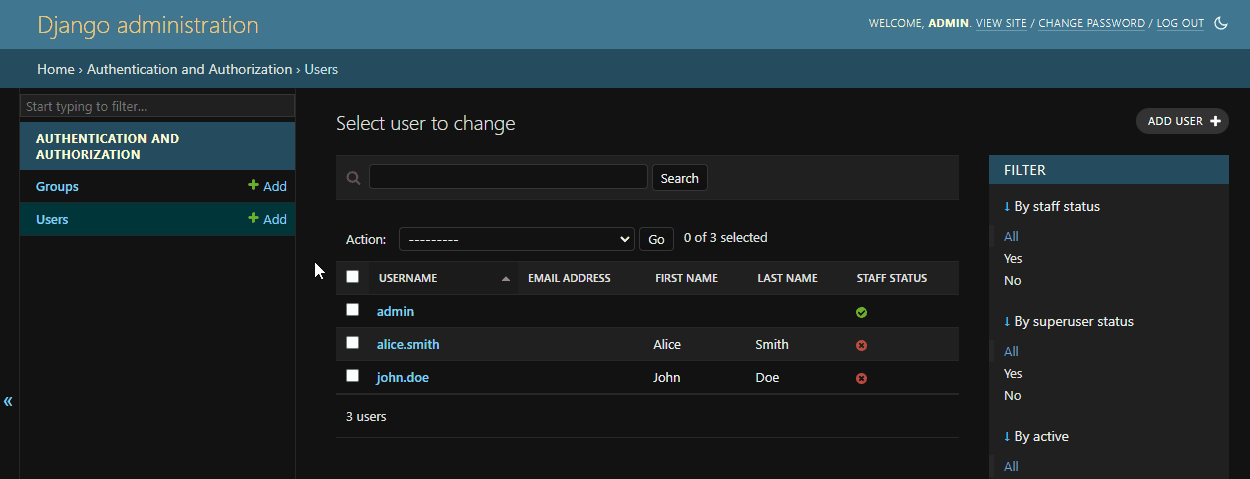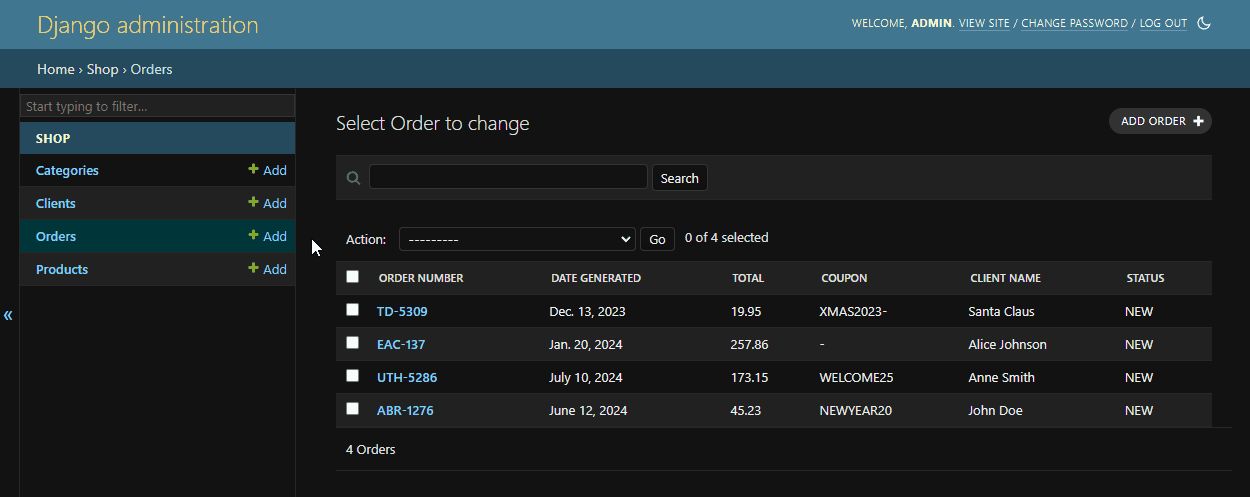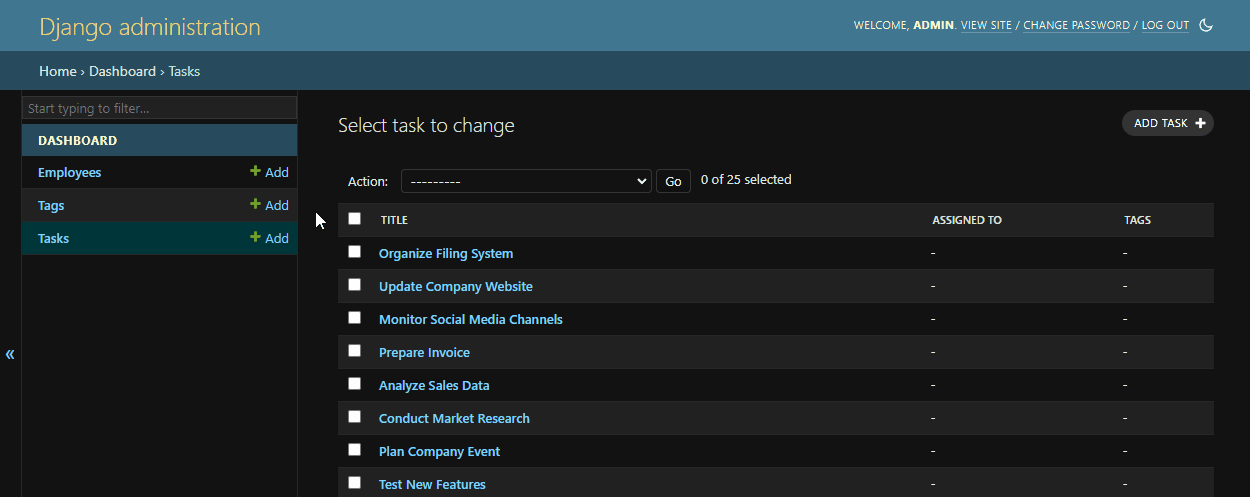Extension for the Django admin panel that allows passing additional parameters to actions by creating intermediate pages with forms.
django-admin-action-forms
Extension for the Django admin panel that allows passing additional parameters to actions by creating intermediate pages with forms.
🚀 Overview
Do you need confirmation pages for your actions in Django admin?
Does creating multiple actions in Django admin that only differ in arguments sound familiar?
Have you ever added a somewhat hacky way to pass additional parameters to an action?
If so, this package is for you!
This is how it looks in action:

By adding a few lines of code, you can create actions with custom forms that will be displayed in an intermediate page before the action is executed. Data from the form will be passed to the action as an additional argument.
Simple and powerful!
🎉 Features
- Requires minimal configuration, easy to use
- Supports all modern Django versions (3.2.x, 4.x.x, 5.x.x)
- Built on top of Django’s templates and forms, matches the Django admin style
- No additional dependencies
- Supports
fields/fieldsets,filter_horizontal/filter_verticalandautocomplete_fields - Works with custom widgets, validators and other Django form features
- Easy to test using Django’s testing tools
- Compatible with django-no-queryset-admin-actions
🔌 Installation
-
Install using
pip:$ pip3 install django-admin-action-forms -
Add
'django_admin_action_forms'to yourINSTALLED_APPSsetting.INSTALLED_APPS = [ ... 'django_admin_action_forms', ] -
Include
'django_admin_action_forms.urls'in yoururls.pyfile. This is needed only if you want to use autocomplete.If you want to include them under the same path as admin site, make sure to place them before the admin URLs.
from django.contrib import admin from django.urls import path, include urlpatterns = [ path("admin/action-forms/", include("django_admin_action_forms.urls")), path("admin/", admin.site.urls), ... ]…or include them under any other path.
from django.contrib import admin from django.urls import path, include urlpatterns = [ path("admin/", admin.site.urls), ... path("any/other/path/", include("django_admin_action_forms.urls")), ]
✏️ Examples
Simple confirm form
Sometimes you do not need any additional parameters, but you want to display a confirmation form before executing the action, just to make sure the user is aware of what they are doing. By default, Django displays such form for the built-in delete_selected action.
Let’s create a simple action that will reset the password for selected users, but before that, we want to display a confirmation form.
from django.contrib import admin
from django.contrib.auth.models import User
from django_admin_action_forms import AdminActionFormsMixin, AdminActionForm, action_with_form
class ResetUsersPasswordActionForm(AdminActionForm):
# No fields needed
class Meta:
list_objects = True
help_text = "Are you sure you want proceed with this action?"
@admin.register(User)
class UserAdmin(AdminActionFormsMixin, admin.ModelAdmin):
@action_with_form(
ResetUsersPasswordActionForm,
description="Reset password for selected users",
)
def reset_users_password_action(self, request, queryset, data):
self.message_user(request, f"Password reset for {queryset.count()} users.")
actions = [reset_users_password_action]
By doing this, we recreated the behavior of intermediate page from the built-in delete_selected action.

Action with parameters
In many cases however, you will want to pass additional parameters to the action. This can be very useful for e.g.:
- Changing the status of
Orderto one of the predefined values - Setting a discount that you input for selected
Productobjects - Adding multiple tags to selected
Articleobjects at once - Sending mails to selected
Userobjects with a custom message, title and attachments
…and many more!
Let’s create an action that will change the status of selected Order to a value that we select using a dropdown.
from django import forms
from django.contrib import admin
from django_admin_action_forms import action_with_form, AdminActionForm
from .models import Order
class ChangeOrderStatusActionForm(AdminActionForm):
status = forms.ChoiceField(
label="Status",
choices=[("new", "New"), ("processing", "Processing"), ("completed", "Completed")],
required=True,
)
@admin.register(Order)
class OrderAdmin(AdminActionFormsMixin, admin.ModelAdmin):
@action_with_form(
ChangeOrderStatusActionForm,
description="Change status for selected Orders",
)
def change_order_status_action(self, request, queryset, data):
for order in queryset:
order.status = data["status"]
order.save()
self.message_user(request, f'Status changed to {data["status"].upper()} for {queryset.count()} orders.')
actions = [change_order_status_action]

You may think that this could be achieved by creating an action for each status, but what if you have 10 statuses? 100? This way you can create a single action that will work for all of them.
And how about parameter, that is not predefined, like a date or a number? It would be impossible to create an action for each possible value.
Let’s create an action form that will accept a discount for selected Products and a date when the discount will end.
from django import forms
from django_admin_action_forms import AdminActionForm
class SetProductDiscountActionForm(AdminActionForm):
discount = forms.DecimalField(
label="Discount (%)",
min_value=0,
max_value=100,
decimal_places=2,
required=True,
)
valid_until = forms.DateField(
label="Valid until",
required=True,
)

Now we can set any discount and any date, and because we subclassed AdminActionForm, we get a nice date picker.
Customizing action form layout
If your form has many fields, you may want to group them into fieldsets or reorder them. You can do this by using the fields, fieldsets, or corresponding methods in Meta.
For Model-related fields, it might be useful to use filter_horizontal/filter_vertical or autocomplete_fields.
Let’s create an action form for action that assigns selected Tasks to Employee, that we will select using autocomplete widget.
Also, let’s add the field for setting the optional Tags for selected Tasks, and validate that no more than 3
are selected using Django’s form validation.
from django import forms
from django_admin_action_forms import AdminActionForm
class AssignToEmployeeActionForm(AdminActionForm):
employee = forms.ModelChoiceField(
queryset=Employee.objects.all(),
required=True,
)
tags = forms.ModelMultipleChoiceField(
queryset=Tag.objects.all(),
required=False,
)
def clean_tags(self):
tags = self.cleaned_data["tags"]
if tags.count() > 3:
raise forms.ValidationError("You can't assign more than 3 tags to a task.")
return tags
class Meta:
autocomplete_fields = ["employee"]
filter_horizontal = ["tags"]

Inlines
In some cases, you may need to pass a list of values to the action. These values could be as simple as numbers or they could have a more complex structure.
By using inlines, you can add formsets to your action form.
This is very useful when you need multiple values that share the same fields, but you do not know exactly how many there will be.
Let’s say you want to set the power level plan for a fan, based on the temperature.
You can do this by creating an action form with inlines, where each inline will represent a range of temperatures and the corresponding power level.
from django import forms
from django_admin_action_forms import InlineAdminActionForm, TabularAdminActionInline, AdminActionForm
class FanPowerLevelInlineForm(InlineAdminActionForm):
temperature_from = forms.IntegerField(required=True)
temperature_to = forms.IntegerField(required=True)
power = forms.IntegerField(
min_value=0,
max_value=100,
required=True,
)
class FanPowerLevelsInline(TabularAdminActionInline):
name = "fan_power_levels"
form = FanPowerLevelInlineForm
extra = 0
initial = [
{"temperature_from": 0, "temperature_to": 50, "power": 40},
{"temperature_from": 50, "temperature_to": 80, "power": 70},
{"temperature_from": 80, "temperature_to": 100, "power": 100},
]
class ConfigureFanPowerLevelsActionForm(AdminActionForm):
scale = forms.ChoiceField(
choices=[
("c", "Celsius"),
("f", "Fahrenheit"),
],
required=True,
label="Scale",
)
class Meta:
inlines = [
FanPowerLevelsInline,
]

Multiple inlines can be used in the same action form, and they will be displayed in the order they are defined in inlines.
Testing action forms
To test action forms, you can use Django’s test client to send POST requests to model changelist with required data. The action and _selected_action fields are required, and the rest of the fields should match the action form fields.
from django.contrib.auth.models import User
from django.test import TestCase
from django.urls import reverse
class ShopProductsTests(TestCase):
def setUp(self):
User.objects.create_superuser(username="admin", password="password")
self.client.login(username="admin", password="password")
def test_set_product_discount_action_form_submit(self):
change_url = reverse("admin:shop_product_changelist")
data = {
"action": "set_product_discount",
"_selected_action": [10, 12, 14],
"discount": "20",
"valid_until": "2024-12-05",
}
response = self.client.post(change_url, data, follow=True)
self.assertContains(response.rendered_content, "Discount set to 20% for 3 products.")
📄 Reference
AdminActionFormsMixin@action_with_formActionFormAdminActionFormActionForm.MetaInlineActionFormInlineAdminActionFormInlineAdminActionFormSetStackedAdminActionInlineTabularAdminActionInline
class AdminActionFormsMixin
Class that should be inherited by all ModelAdmin classes that will use action forms. It provides the logic for displaying the intermediate page and handling the form submission.
from django.contrib import admin
from django_admin_action_forms import AdminActionFormsMixin
class ProductAdmin(AdminActionFormsMixin, admin.ModelAdmin):
...
@action_with_form(form_class, *, permissions=None, description=None)
Works similar to
@admin.action
Decorator that can be used instead of @admin.action to create action with custom form.
Functions decorated with @action_with_form should accept additional argument data that will contain cleaned data from the form, permissions and description work the same.
@action_with_form(
CustomActionForm,
description="Description of the action",
)
def custom_action(self, request, queryset, data):
value_of_field1 = data["field1"]
optional_value_of_field2 = data.get("field2")
...
class ActionForm
Works similar to
Form
Base class for creating action forms responsible for all under the hood logic. Nearly always you will want to subclass AdminActionForm instead of ActionForm, as it provides additional features.
def __init__(self, *args, **kwargs)
From version 2.0.0 replaces
__post_init__method
Constructor for action forms that can be used to dynamically modify the form based on the modeladmin, request and queryset that are passed to the constructor and accessible from self.
It is possible to add, modify and remove fields, change the layout of the form and other options from Meta class.
class CustomActionForm(AdminActionForm):
def __init__(self, *args, **kwargs):
super().__init__(*args, **kwargs)
if self.request.user.is_superuser:
self.fields["field1"].required = False
self.opts.fields = ["field2", "field1"]
self.opts.list_objects = self.queryset.count() > 10
def action_form_view(self, request, extra_context=None)
Added in version 2.0.0
Method used for rendering the intermediate page with form. It can be used to do some checks before displaying the form and e.g. redirect to another page if the user is not allowed to perform the action.
It can also be used for providing extra_context to the template, which can be especially useful when extending the action form template.
class CustomActionForm(AdminActionForm):
def action_form_view(self, request, extra_context=None):
if self.queryset.count() > 3:
self.modeladmin.message_user(
request, "No more than 3 objects can be selected.", "error"
)
return HttpResponseRedirect(request.path)
return super().action_form_view(request, {"custom_context_value": ...})
class AdminActionForm
In addition to ActionForm, it replaces default widgets for most field types with corresponding Django admin widgets that e.g. add a interactive date picker or prepend a clickable link above URL fields.
Most of the time this is a class you want to subclass when creating custom action forms.
class CustomActionForm(AdminActionForm):
field1 = forms.ChoiceField(
label="Field 1",
choices=[(1, "Option 1"), (2, "Option 2"), (3, "Option 3")],
)
field2 = forms.CharField(
label="Field 2",
required=False,
widget=forms.TextInput
)
field3 = forms.DateField(label="Field 3", initial="2024-07-15")
...
class ActionForm.Meta
Works similar to some
ModelAdminoptions
Additional configuration for action forms. It can be used to customize the layout of the form, add help text, or display a list of objects that will be affected by the action.
class CustomActionForm(AdminActionForm):
...
class Meta:
list_objects = True
help_text = "This is a help text"
...
Below you can find all available options:
list_objects
Default: False
If True, the intermediate page will display a list of objects that will be affected by the action similarly
to the intermediate page for built-in delete_selected action.
class Meta:
list_objects = True
help_text
Default: None
Text displayed between the form and the list of objects or form in the intermediate page.
class Meta:
help_text = "This text will be displayed between the form and the list of objects"
fields
Works similar to
ModelAdmin.fields
Default: None
Specifies the fields that should be displayed in the form. If fieldsets is provided, fields will be ignored.
class Meta:
fields = ["field1", ("field2", "field3")]
def get_fields(request)
Works similar to
ModelAdmin.get_fields()
Method that can be used to dynamically determine fields that should be displayed in the form. Can be used to reorder, group or exclude fields based on the request. Should return a list of fields, as described above in the fields.
class Meta:
def get_fields(self, request):
if request.user.is_superuser:
return ["field1", "field2", "field3"]
else:
return ["field1", "field2"]
fieldsets
Works similar to
ModelAdmin.fieldsets
Default: None
If both fields and fieldsets are provided, fieldsets will be used.
class Meta:
fieldsets = [
(
None,
{
"fields": ["field1", "field2", ("field3", "field4")],
},
),
(
"Fieldset 2",
{
"classes": ["collapse"],
"fields": ["field5", ("field6", "field7")],
"description": "This is a description for fieldset 2",
},
),
]
def get_fieldsets(request)
Works similar to
ModelAdmin.get_fieldsets()
Method that can be used to dynamically determine fieldsets that should be displayed in the form. Can be used to reorder, group or exclude fields based on the request. Should return a list of fieldsets, as described above in the fieldsets.
class Meta:
def get_fieldsets(self, request):
if request.user.is_superuser:
return [
(
None,
{
"fields": ["field1", "field2", ("field3", "field4")],
},
),
(
"Fieldset 2",
{
"classes": ["collapse"],
"fields": ["field5", ("field6", "field7")],
"description": "This is a description for fieldset 2",
},
),
]
else:
return [
(
None,
{
"fields": ["field1", "field2", ("field3", "field4")],
},
),
]
[!NOTE]
Only one ofget_fieldsets,fieldsets,get_fieldsorfieldsshould be defined in theMetaclass.
The order of precedence, from highest to lowest, is from left to right.
filter_horizontal
Works similar to
ModelAdmin.filter_horizontal
Default: None
Sets fields that should use horizontal filter widget. It should be a list of field names.
class Meta:
filter_horizontal = ["tags"]
filter_vertical
Works similar to
ModelAdmin.filter_vertical
Default: None
Sets fields that should use vertical filter widget. It should be a list of field names.
class Meta:
filter_vertical = ["tags"]
autocomplete_fields
Works similar to
ModelAdmin.autocomplete_fields
Default: None
Sets fields that should use autocomplete widget. It should be a list of field names.
class Meta:
autocomplete_fields = ["employee"]
[!NOTE]
Autocomplete requires including'django_admin_action_forms.urls'in yoururls.pyfile.
See 🔌 Installation.
radio_fields
Works similar to
ModelAdmin.radio_fields
Added in version 2.1.0
Default: {}
Sets fields that should use a radio-button interface.
You have the choice of using HORIZONTAL or VERTICAL from the django.contrib.admin module.
Don’t include a field in radio_fields unless it’s a ChoiceField or its subclass.
class Meta:
radio_fields = {
"field1": admin.HORIZONTAL,
"field2": admin.VERTICAL,
}
inlines
Works similar to
ModelAdmin.inlines
Added in version 2.1.0
Default: []
Sets inlines that should used in the form.
It should be a list of classes based on StackedAdminActionInline or TabularAdminActionInline.
class Meta:
inlines = [
CustomAdminActionInline,
]
def get_inlines(request)
Works similar to
ModelAdmin.get_inlines()
Added in version 2.1.0
Method that can be used to dynamically determine inlines that should be used in the form.
Should return a list of classes based on StackedAdminActionInline or TabularAdminActionInline.
class Meta:
def get_inlines(self, request):
if request.user.is_superuser:
return [
CustomAdminActionInline
]
else:
return []
confirm_button_text
Added in version 1.2.0
Default: "Confirm"
Text displayed on the confirm button. It can be either a str or a lazy translation.
from django.utils.translation import gettext_lazy as _
class Meta:
confirm_button_text = _("Proceed")
cancel_button_text
Added in version 1.2.0
Default: "Cancel"
Text displayed on the cancel button. It can be either a str or a lazy translation.
from django.utils.translation import gettext_lazy as _
class Meta:
cancel_button_text = _("Abort")
class InlineActionForm
class InlineAdminActionForm
Added in version 2.1.0
Version of ActionForm and AdminActionForm that is used for inlines. Supports all of the features of ActionForm and selected Meta options.
Because some Meta options like list_objects or help_text do not make sense in the context of inlines, they do nothing.
That said, you can still use e.g. fields, filter_horizontal, or autocomplete_fields.
class CustomInlineActionForm(InlineActionForm):
field1 = forms.ChoiceField(
label="Field 1",
choices=[(1, "Option 1"), (2, "Option 2"), (3, "Option 3")],
)
field2 = forms.CharField(
label="Field 2",
required=False,
widget=forms.TextInput
)
field3 = forms.DateField(label="Field 3", initial="2024-07-15")
...
class InlineAdminActionFormSet
class StackedAdminActionInline
class TabularAdminActionInline
Works similar to
InlineModelAdmin
Added in version 2.1.0
Class that defines the layout of inline formset as well as its other options not directly related to the form.
All subclasses of InlineAdminActionFormSet should have prefix and form defined, all other attributes are optional.
class CustomAdminActionInline(StackedAdminActionInline):
name = "something"
form = CustomActionInlineForm
verbose_name = "..."
verbose_name_plural = "..."
extra = 3
min_num = 1
max_num = 5
classes = ["collapse"]
initial = [
{"field1": ..., "field2": ...},
{"field1": ..., "field2": ...},
]
name
A string used internally by the formset. It should be a valid python identifier, and when using multiple inlines inside one action form, each inline should have a unique name. It is used as a key in data dictionary that is passed to the action.
This is required.
form
Works similar to
InlineModelAdmin.model
Form used in the formset. It should be a subclass of InlineAdminActionForm or InlineActionForm.
This is required.
extra
Works similar to
InlineModelAdmin.extra
Default: 1
Number of extra forms the formset will display in addition to the initial forms.
def get_extra(request)
Works similar to
InlineModelAdmin.get_extra()
Returns the number of extra inline forms to use. By default, returns the InlineAdminActionFormSet.extra attribute.
Override this method to programmatically determine the number of extra inline forms.
min_num
Works similar to
InlineModelAdmin.min_num
Default: 0
Minimum number of forms to show in the inline.
def get_min_num(request)
Works similar to
InlineModelAdmin.get_min_num()
Returns the minimum number of inline forms to use. By default, returns the InlineAdminActionFormSet.min_num attribute.
Override this method to programmatically determine the minimum number of inline forms.
max_num
Works similar to
InlineModelAdmin.max_num
Default: 1000
Maximum number of forms to show in the inline.
def get_max_num(request)
Works similar to
InlineModelAdmin.get_max_num()
Returns the maximum number of extra inline forms to use. By default, returns the InlineAdminActionFormSet.max_num attribute.
Override this method to programmatically determine the maximum number of inline forms.
verbose_name
Works similar to
InlineModelAdmin.verbose_name
Used in inline template to display the name of the formset. It should be a string or a lazy translation. By default it uses the InlineAdminActionFormSet.prefix attribute.
verbose_name_plural
Works similar to
InlineModelAdmin.verbose_name_plural
If this isn’t given and the InlineAdminActionFormSet.verbose_name is defined, it will be set to InlineAdminActionFormSet.verbose_name + 's'.
classes
Works similar to
InlineModelAdmin.classes
Default: []
A list or tuple containing extra CSS classes to apply to the fieldset that is rendered for the inlines. As with classes configured in ModelAdmin.fieldsets, inlines with a "collapse" class will be initially collapsed using an expandable widget.
initial
Works similar to
FormSet.initial
Default: None
List of dictionaries used to prepopulate the formset with initial data. Each dictionary should contain the same keys as the fields in the formset.

